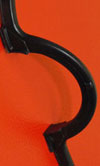Seal Elastomers - the lubricant angle.
 The interaction between the elastomer seals in an engine and its lubricant is an ongoing battle. Referred to simply as 'compatibility issues' by the specialists, the damage inflicted on the seal by the lubricant can manifest itself in two ways. The first of these is considered to be the direct chemical attack on the elastomer matrix resulting in its loss of performance (as a seal) while the second is the combined effect of this and the dynamic stresses applied. While the latter can be addressed by thorough dynamic testing, much of which is long term on durability rigs, the former is often simply down to the chemistry of the constituent components.
The interaction between the elastomer seals in an engine and its lubricant is an ongoing battle. Referred to simply as 'compatibility issues' by the specialists, the damage inflicted on the seal by the lubricant can manifest itself in two ways. The first of these is considered to be the direct chemical attack on the elastomer matrix resulting in its loss of performance (as a seal) while the second is the combined effect of this and the dynamic stresses applied. While the latter can be addressed by thorough dynamic testing, much of which is long term on durability rigs, the former is often simply down to the chemistry of the constituent components.
That modern engine lubricants are a complex cocktail of chemicals, required to perform a range of functions, (lubrication, cooling, cleaning, friction reduction, protection, and so on) is most likely well understood. And while the base oil will constitute between 60 to 90 % or more of the overall volume, the remaining part, that of the additive pack, can have as many issues associated with it as the choice of base oil itself.
Base oils can introduce swelling or shrinkage to a seal according to the type of oil and the elastomer used but it is the additive pack that can sometimes have the most unintended of effects. One of the most common historically was the cross linking of nitrile rubbers by lubricants. The active sulphur, part of the extreme anti-wear agent, zinc dialkyldithiophosphate, can react with the double bonds present in nitrile rubber and other elastomers to appreciably increase this cross linking density. The result is hardening of the rubber and subsequent cracking.
Molybdenum disulphide, a common solid lubricant included in many greases cannot be introduced into traditional engine lubricants because of its insolubility. However, soluble versions of this product, again often used as extreme pressure agents, in the form of molybdenum dithiocarbamates or dithiophosphates can also cause cross linking in nitrile rubbers. In the case of dithiophosphates this can also lead to de-polymerisation of silicone rubbers.
Perhaps the most concerning in recent times, is the effect on fluoroelastomers by free amines present in modern day lubricant dispersants and some friction modifiers. These dispersants are present in the oil to prevent the agglomeration of degradation products caused by oxidation or thermal stressing of the lube, which might otherwise cause harmful deposits. Because of their thermal stability and durability, fluoroelastomers have become a desirable seal material in engines but even a small amount of basic amine present in the oil in the form of a dispersant can result in dehyrofluorination leading to premature failure. Base resistant fluoroelastomers have been developed to offset this issue, but in formulating oils and balancing the needs of long term stability, soot handling capability and overall engine cleanliness, taking into account both new and older seal materials, this is a task not to be taken lightly.
In many cases it has been up to the oil industry to develop solutions to these sealing issues but, in the case of RTVs or Room Temperature Vulcanising sealants, similar to those used commonly in engine build, the converse is true. First generation sealants of this type produced the by-product acetic acid, which leached out into the oil after curing. This reduced the base reserve in the oil designed initially to 'mop up' all the weak acids caused during the combustion process. RTVs developed for use in engines have now addressed this problem. However a secondary issue, the leaching of low molecular weight silicone plasticizers from the sealant into the oil is causing major concern. In the oil industry high molecular weight silicones are used to inhibit foaming in engine oil. Insoluble in the base stock in order to work effectively, they are dispersed through the oil by clever formulation. Silicone plasticizers however are soluble in the base oil and rather than working to prevent the formation of foam, actually stabilise it. In any engine particularly competition engines, the presence of foam because of these silicones can have potentially catastrophic consequences.
Fig. 1 - Highly Saturated Nitrile Rubber seal.
Written by John Coxon